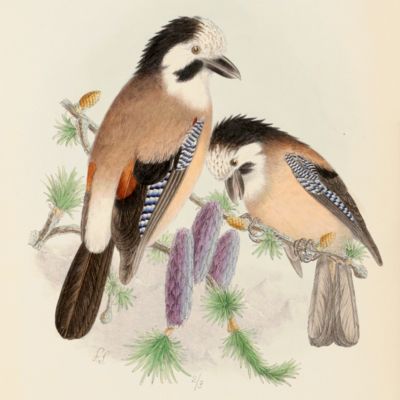Sharpe, R. B.
Scientific results of the Second Yarkand Mission; based upon the collections and notes of the late Ferdinand Stoliczka, Ph.D. Aves.
London, Taylor and Francis [by order of the Government of India], [1878]-1891. Large 4to (31.4 x 25.7 cm). Titlepage, [iii]-xviii, 153 pp.; 24 finely hand-coloured, lithographed plates, mostly by J. G. Keulemans. 20th-century red half morocco over red linen. Spine with five raised, gilt-stippled bands; compartments gilt-lined; gilt title. Marbled endpapers.
The complete ornithology of a region until then hardly visited by naturalists. Yarkand [now Yarkant County, also Shache County, also transliterated from Uyghur as Yakan County], is a county in the Xinjiang Uyghur Autonomous Region, China, located on the southern rim of the Taklamakan Desert in the Tarim Basin. The county, usually referred to as Yarkand in English, was the seat of an ancient Buddhist kingdom on the southern branch of the Silk Road and the Yarkand Khanate. The county sits at an altitude of nearly 1200 metres. The Mission was led by the British diplomat Sir Thomas Douglas Forsyth (1827-1886) and for the scientific part by the Moravian zoologist and palaeontologist Ferdinand Stoliczka (Czech Stolička) (1838-1874). He "studied geology and palaeontology at Prague and the University of Vienna under Professor Eduard Suess and Dr Rudolf Hoernes. ... In 1862 Stoliczka joined the Geological Survey of India (GSI) under the British Government in India after being recruited by Dr Thomas Oldham (1816-1878)" (Wikipedia). This work was published in 14 Parts between 1878 and 1891. "The ornithological collections were first treated by Allan Hume, but his manuscript was stolen and sold as wastepaper ... In an appendix (pp 149-152) mention is made of some Indian birds, which are figured on Pl. XVI-XXIV" (Anker, p. 195). This published version was written by the British zoologist (chiefly ornithologist) and librarian Richard Bowdler Sharpe (1847-1909), author of many fine bird books. According to Zimmer (p. 580), despite the title, the work includes observations made by Dr Henderson during the First (1873) Yarkand Mission, which was much less centred on natural history. Of the fine plates, 15 were made by the famous Anglo-Dutch explorer, ornithologist, and artist John Gerrard Keulemans (1842-1912), who previously illustrated Sharpe's Monograph of the Alcedinidae ( Kingfishers) (1868-1871), the other plates are by the British zoological illustrator William Matthew Hart (1830-1908), who also worked for the famous ornithologist John Gould. However, Anker (p. 192) states that some plates may have been made by another famous Anglo-Dutch natural history artist, Joseph Smit (1836-1929), and, indeed, the last two - Indian - bird plates are signed by Smit. Jackson is inaccurate suggesting that both Hart (p. 58) and Keulemans (p. 92) were responsible for all 24 plates. Minimal toning of the top edge of several pages; one plate with limited, minimal foxing, otherwise an entirely clean, absolutely mint copy. Anker, 465; Jackson, Bird Illustrators. Some Artists in Early Lithography, pp. 58, 92; Keulemans, T. and J. Coldewey, Feathers to Brush, p. 65; Nissen IVB, 861; Nissen ZBI, 4760 (incomplete listing); Sitwell, Fine Bird Books 1700-1900, p. 142; Zimmer, p. 580.




